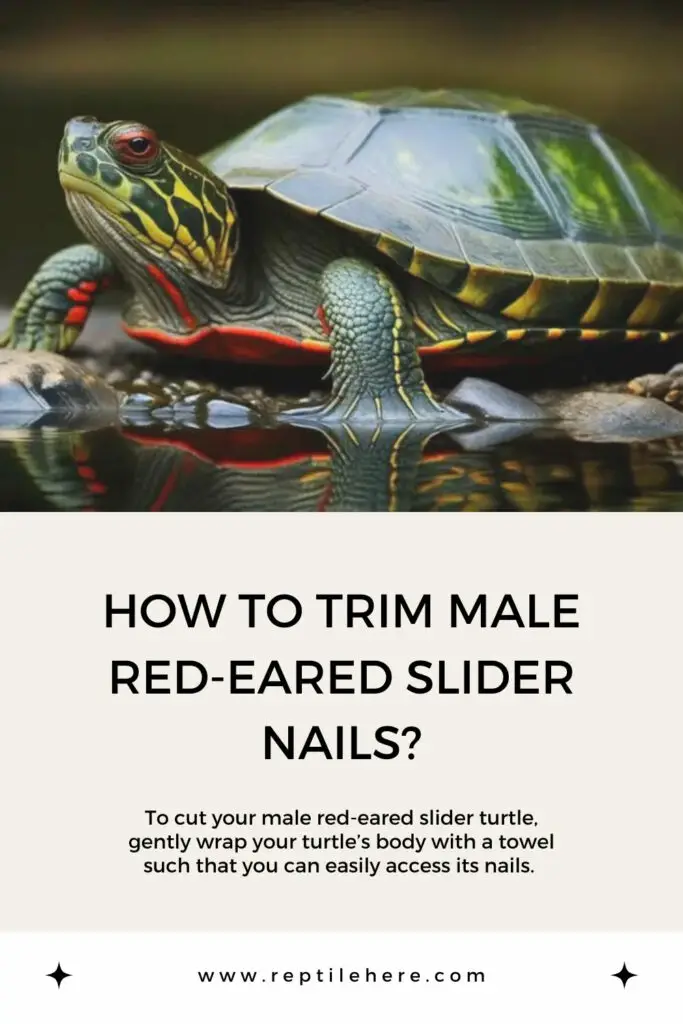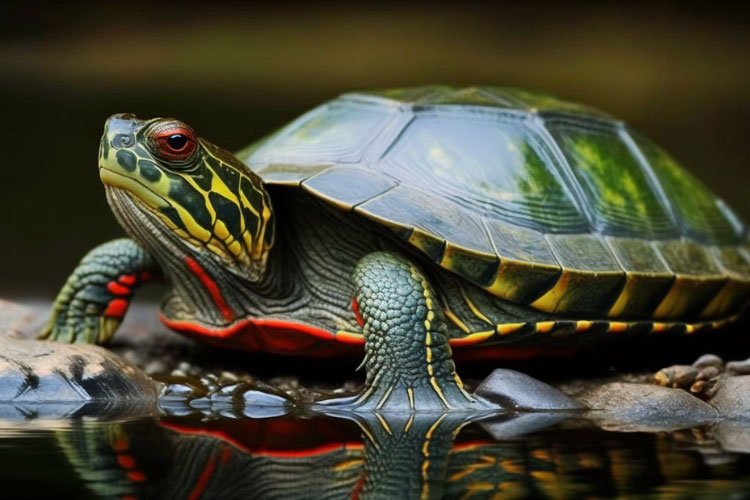How To Trim Male Red-Eared Slider Nails
If your red-eared slider nails have grown too long, you’re probably considering cutting them as his caretaker to ensure they don’t give him a hard time when walking, climbing, or snag on things and break. But how exactly do you trim the nails nicely?
How to trim male red-eared slider nails? To cut your male red-eared slider turtle, gently wrap your turtle’s body with a towel such that you can easily access its nails. Then, use a sharp nail clipper to cut the long nails, one claw at a time. Don’t cut too close to the skin to avoid cutting blood vessels and injuring your turtle.
In the following guide, we’ll teach you how to trim your male red-eared slider nails correctly and in a safe manner without hurting your turtle. We’ll also discuss whether it’s okay to cut your turtle nails when they grow long or if you should just let them be.
How to trim a male red-eared slider’s nails?
Contents
Long nails are a characteristic of all male Red Eared Sliders (RES). But if they grow too long, your turtle may have difficulties walking, and climbing, and may even get stuck on objects in its enclosure. This necessitates the need to trim the claws.
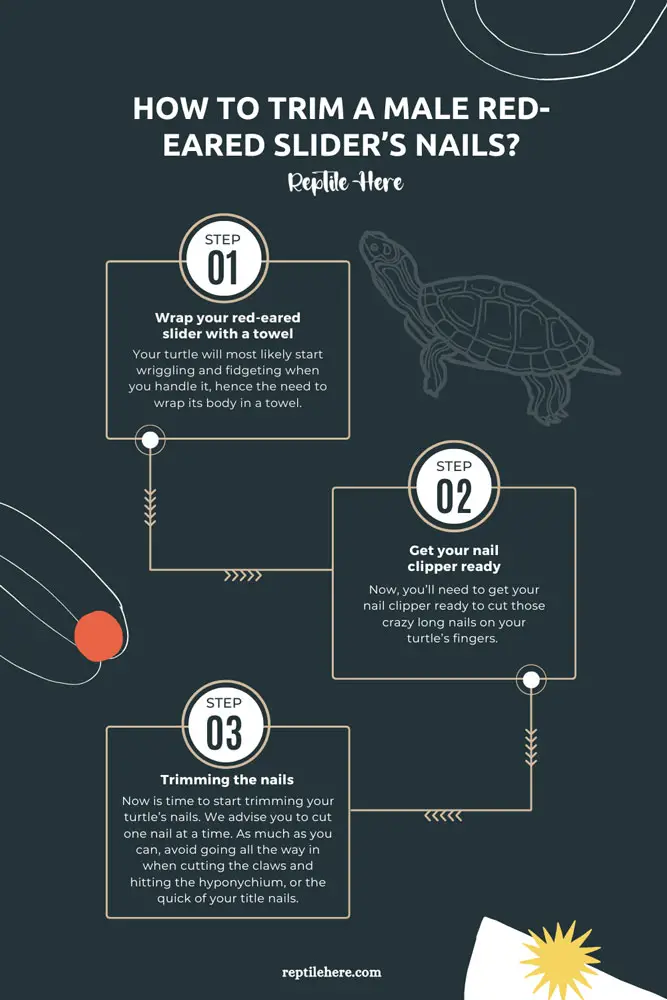
Let’s discuss the full details on how to cut your red-eared slider nails:
Things you’ll need:
- Towel
- Well-sharpened nail clipper for reptiles
- First aid kit
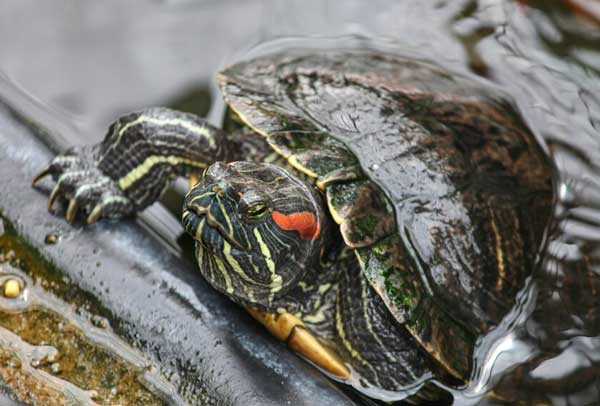
Directions for trimming the nails:
Follow the steps we’ve outlined below to safely and correctly trim your male RES nails
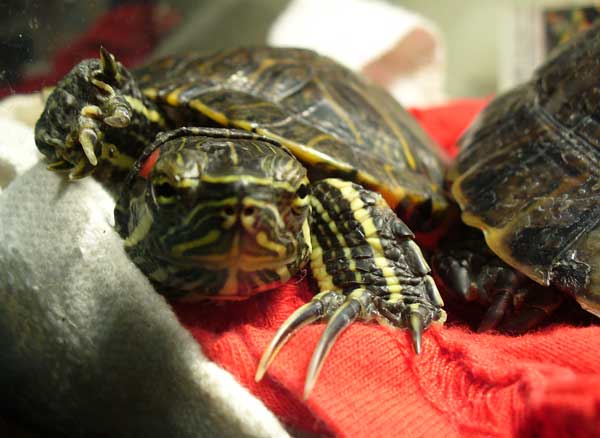
Step 1. Wrap your red-eared slider with a towel
Your turtle will most likely start wriggling and fidgeting when you handle it, hence the need to wrap its body in a towel. This will help bind the turtle and minimize movements that may cause you to injure it during trimming.
Besides, a towel helps make your turtle feel more comfortable in your hands while giving you a better grip compared to bare hands.
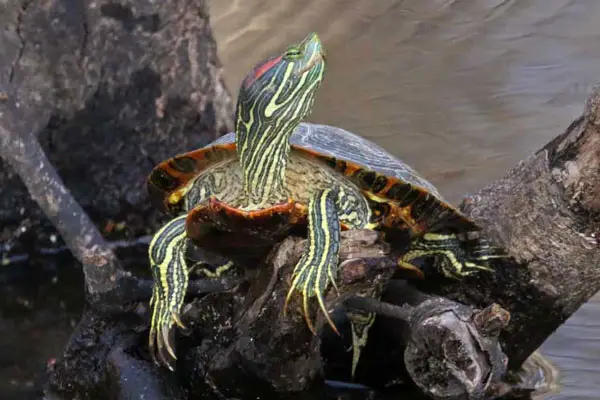
But don’t make the wrapping too tight. Only crate an opening with the towel for the nails you’re trimming to ensure a better grip. Now you can place your turtle on a table or on your lap, or you can get an extra hand to help you hold it while you trim its nails.
Step 2. Get your nail clipper ready
Now, you’ll need to get your nail clipper ready to cut those crazy long nails on your turtle’s fingers. For this step, we advise using a well-sharpened nail caliper to make the cutting process easy and to avoid injuring your turtle with blunt clippers.
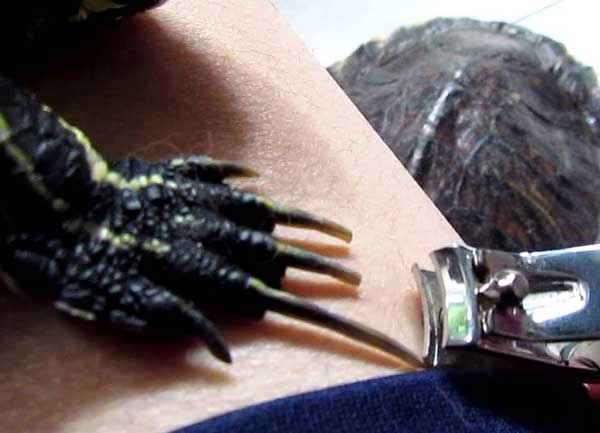
The right type of nail clipper to use will depend on the size of your turtle and how big its nails are. You can use a reptile-specific nail cutter for this task. Alternatively, you can use a cat clipper (for small nails) or a dog clipper (for bigger nails).
Step 3. Trimming the nails
Now is time to start trimming your turtle’s nails. We advise you to cut one nail at a time. As much as you can, avoid going all the way in when cutting the claws and hitting the hyponychium, or the quick of your title nails.
Otherwise, you may easily cut the blood vessels in this area and leave your turtle hurting with injuries or sore toes.
Once you’re done trimming one limb, you can move on to the next, trimming each nail at a time. If you see the quick is too near (youkan easily view it if you look closer), leave the nail without trimming. You don’t want to hurt your turtle in any way!
Watch the following video of a turtle owner clipping his slider nails
Video:
Helpful tips for trimming your red-eared slider nails
In addition to following the key procedure above, there are additional tips to keep in mind when tripping when your slider’s nails as outlined below:
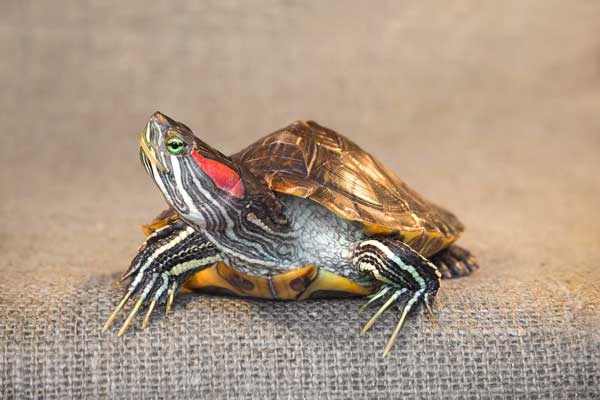
- Keep the nails immobilized during the trimming process to prevent the possibility of injuring your pet
- Avoid forcing your turtle to stretch its limbs by shaking or jiggling it. This will stress it and may even cause injuries.
- If your turtle becomes uncooperative or agitated, stop the trimming exercise and try it later. Else, it may become stressed and even bite you if it feels threatened.
- Put your turtle back into its enclosure after you’re done trimming it to give it time to relax
- If you accidentally cut a blood vessel, use the first aid kit to stop the bleeding and prevent an infection from occurring in the affected area
- If you don’t feel comfortable trimming the turtle’s nails on your own, then you can bring him a vet or a professional reptile handler to do it for you at a fee.
Are you supposed to cut male red-eared slider nails?
Absolutely! You should cut your male RES nails as part of your turtle care to help stay healthy.
Captive turtles’ nails tend to grow too long unlike in the wild where they naturally wear out as they walk on hard rocks, bask on rough surfaces, etc.
When your male slider nails grow too long, they may make it hard for your little friend to walk around or climb.
The long nails may also easily snag on things in their enclosure. And as your turtle attempts to free itself, the stuck nails may get broken and your turtle will be left with injuries. Or they can scratch and injure you when you hold your turtle.
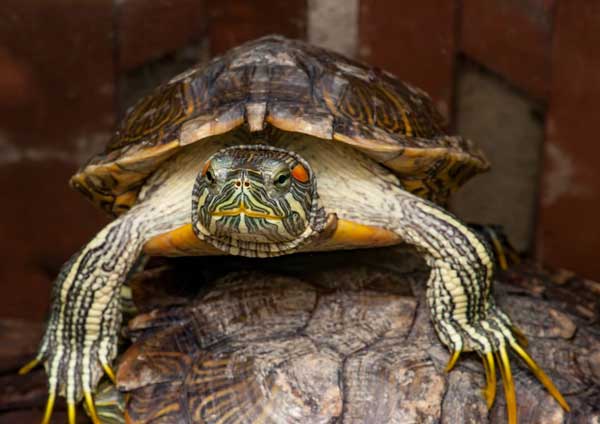
To avoid these unfortunate incidences from happening, we highly encourage you to cut your male red-eared slider nails.
But only do it when the claws are overgrown. And follow the method we described above to avoid hurting your turtle and drawing blood.
Why shouldn’t you cut your red-eared slider nails?
Some people advise against cutting male red-eared slider turtle nails. One of the reasons behind this is that the males use them to attract females for breeding.
Long claws define dominance and masculinity in males, enabling them to easily attract females for mating. This is helpful if you’re a breeder, so you should rethink trimming your slider nails.
Another reason they give for not trimming the nails is that they need these long nails to break down large bits of food.
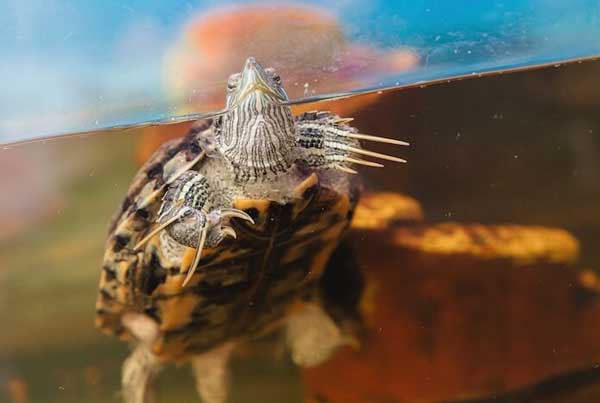
They also mention that the red-eared sliders are aquatic and spend more time swimming than walking, long nails won’t affect their movement in any way.
However, you can’t completely ignore the possibility of the long nails getting stuck on objects in your turtle’s tank.
Another reason to not trim your turtle nails is that you may end up injuring them. As we have said above, you can easily cut into the nails quick if you’re not careful and inflict injuries on your pet.
Will it hurt your red-eared slider if you trim its nails?
It can hurt your red-eared slide if you trim its nails incorrectly. The rule of thumb is to not cut them too short—past the quick, where the nerves and blood vessels are located.
If you go anywhere near this pigmented area, you’ll hurt your pet turtle and it will start bleeding!
Keep a first aid kit within reach. These help you administer first aid to your pet in case he gets accidentally injured during the trimming process.

What to do if your male red-eared slider has broken nail?
If your turtle has broken its nail, then you should take immediate action to prevent an infection from occurring in the area.
Clean the area using hydrogen peroxide. Next, apply a styptic pencil or cornstarch to stop the bleeding. Finally, apply an antibacterial ointment to prevent possible infections.
If the nail doesn’t heal with time, or if you notice signs of infection, consult your vet.
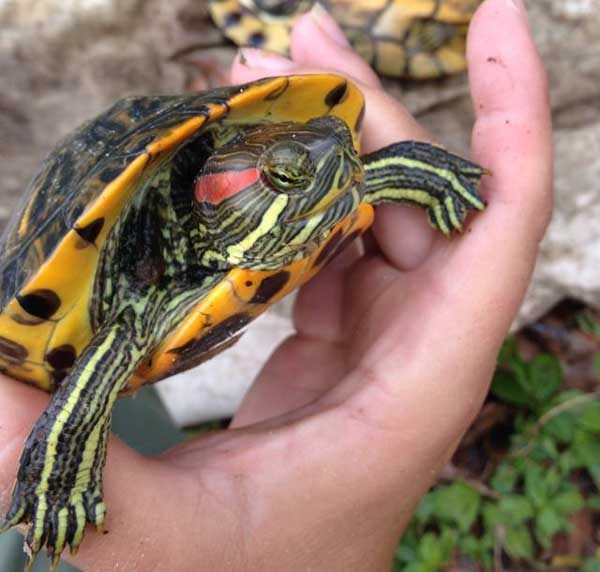
FAQs:
When trimming your red-eared slider, wrapping it with a towel will help minimize movement for safer trimming. You can also use your bare hands to safely handle your turtle for trimming as shown in the video below.
Video:
You know it’s time to cut your turtle nails if they become too long. One tell-tale sign of overgrown turtle nails is if they have started curving under the feet. If your turtle keeps catching things and has difficulty walking, you’ll also need to cut its nails.
If you accidentally injure your turtle’s nail during the trimming process, simply apply hydrogen peroxide to the injured nail with the help of a cotton swab or sterilized gauze. Next, dry the area completely and then apply the styptic on the area to stop the bleeding and harden the wound.
Final Verdict
Trimming your male red-eared slider pet nails becomes easy once you know how to do it correctly. We’ve just laid out the key procedure for safely cutting your turtle’s nails properly and the tips and precautions to take to avoid hurting your pet during the process.
Remember to only trim your pet turtle nails when they’ve overgrown. And be sure to handle your turtle properly so it doesn’t bite you during the trimming process. Don’t hesitate to seek professional advice from your vet if you have any concerns regarding your turtle’s nails.
